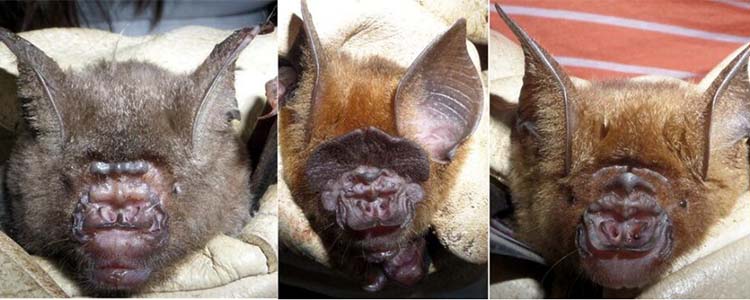Spooky! Bats' Nostril Ornaments May Explain Secrets Of Powerful Sonar System

Old World leaf-nosed bats contain facial features known as "noseleaves" that may significantly enhance bats' sonar systems.
Rolf Müller et al., Virginia Tech
(Inside Science) -- Halloween displays show off bats once a year, but some scientists and engineers devote their entire careers to unlocking the many mysteries of these winged mammals. Among many other attributes, bats have an amazing sonar system, which helps them to navigate their environments and detect prey. Even after a century of development, the most sophisticated artificial sonar systems have not equaled the natural sonar systems of bats and other species. This week, as Halloween approached, researchers presented one reason why this may be so, at least for a couple of bat species: it may be that the super-sophisticated structures around their nostrils, once seen merely as facial ornaments, actually act like complex megaphones for outgoing sonar signals.
Bats release ultrasound, which simply means sound that is higher-pitched than people can hear, from either their mouths or nostrils. The ultrasound bounces from objects in the bats' environment and returns to their ears to provide information about their surroundings. This process of "echolocation" helps bats both find little morsels to eat and avoid obstacles. Sound can be visualized as a rippling water wave, with the distances between two ripples equaling the sound's wavelength. Ultrasound has shorter wavelengths than audible sound, and can therefore pick up information about smaller details within the bat's environment.
Humans like to create ultrasound too, and are building ever-more-sophisticated sonar systems. Artificial sonar systems help submarines navigate the oceans, and more recently, they have appeared in cars, to warn automobile drivers of possible collisions. Artificial sonar systems often contain large numbers of simple ultrasound speakers to broadcast the sound, and multitudes of sensors for detecting them. But these often-sprawling sonar devices are no match for the bat, which has had millions of years of evolution to hone its natural systems. What are the bat's secrets, and how can engineers learn from them to design better sonar systems?
To get some clues, Rolf Müller and his colleagues at Virginia Tech in Blacksburg studied two species, horseshoe bats and Old World leaf-nosed bats. In these species, ultrasound is released from the nostrils, which are surrounded by special body parts known as "noseleaves." A noseleaf can have various kinds of shapes, depending on the bat species, which can resemble a leaf (naturally), a horseshoe, or a spearhead. The noseleaves amplify the ultrasound, in the same way that a megaphone helps direct and amplify a person's voice into a crowd.
Presenting their work at this week's meeting of the Acoustical Society of America in Indianapolis, the researchers described some special noseleaf properties. The noseleaves have a complex shape, and their walls can change rapidly as the ultrasound comes out. So unlike a megaphone, which forces sound to travel through fixed walls, the noseleaves have a changing shape that interacts with ultrasound as it leaves the bat's nostrils. The researchers think that this may enable the bats to send more sophisticated signals, which then echo from their surroundings to deliver specialized information from their environment to their ears. Therefore, the sonar system of these bats is dynamic, with its transmitters changing over time. While other bat species may have different anatomies, such as releasing ultrasound through their mouths, the researchers note that these natural sonar systems, and those of other species such as dolphins, are also dynamic in a similar way.
Müller and his colleagues caution that they do not yet have conclusive evidence that the changing noseleaves are the bats' secret sauce for sophisticated sonar. However, they believe the very specialized machinery would most likely have developed for an important purpose such as improving its echolocation. While many features of bats may appear simply strange, especially during a spooky Halloween celebration, the noseleaves may have a purpose that could someday improve our own navigation and detection systems.

